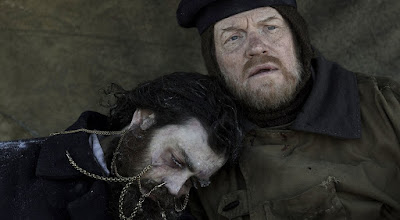 |
| Drawing by Danny Aaluk for Louie Kamookak |
My late friend Louie Kamookak, whose work on Inuit traditional knowledge has been such a significant part of the many new discoveries made in the past few years, had hoped to make a fresh search for this storied vault in the summer of 2018 -- a search that, alas, is not to be -- but I know that others will take up the cause and carry on. Some years ago, he asked Gjoa Haven artist Danny Aaluk to draw an image of this vault as it was described; in Louie's version, the post may have been the vertical part of a wooden cross (see above), though in other reconstructions it's been imagined as a flagpole.
Tom Gross, who accompanied Dave Woodman on several of his "Project Supunger" searches (Supunger or See-pun-ger is the Inuk whose stories of a stone vault, told to Charles Francis Hall, started it all), has searched nearly every year, and hopes to return this summer as well, and several other parties will be in the area. Much depends on good planning (getting all the needed permits from the Government of Nunavut), good weather, and good luck -- but there's no reason that this might not be the year that the site is located. The short searching season, and the uniformity of the flat, rocky, barren land are obstacles -- but surely, with enough effort, the land can yield more of its secrets.
I wish Tom and everyone else all the best in their endeavors. And, knowing how widely the Franklin story is now known -- much more so in the wake of AMC's "The Terror" series -- I thought it might be useful to place some of the original testimony and accounts here. I've created a separate page for the Inuit testimony itself, and would also note the following frequently-asked questions/assumptions:
Tom Gross, who accompanied Dave Woodman on several of his "Project Supunger" searches (Supunger or See-pun-ger is the Inuk whose stories of a stone vault, told to Charles Francis Hall, started it all), has searched nearly every year, and hopes to return this summer as well, and several other parties will be in the area. Much depends on good planning (getting all the needed permits from the Government of Nunavut), good weather, and good luck -- but there's no reason that this might not be the year that the site is located. The short searching season, and the uniformity of the flat, rocky, barren land are obstacles -- but surely, with enough effort, the land can yield more of its secrets.
I wish Tom and everyone else all the best in their endeavors. And, knowing how widely the Franklin story is now known -- much more so in the wake of AMC's "The Terror" series -- I thought it might be useful to place some of the original testimony and accounts here. I've created a separate page for the Inuit testimony itself, and would also note the following frequently-asked questions/assumptions:
• Might not Sir John have been "buried at sea"? Other commanders were given this kind of burial, but given Franklin's importance -- and the fact that, just to get to the "sea" his crews would have had to blast a hole in the ice -- this seems to be unlikely. His men may at the time have cherished the idea of returning his remains to England, which also augurs for a land burial.
• Might Franklin have been preserved on board, either in a keg of rum a là Nelson, or in a coffin? Might he even be the heavy man with the "long teeth"? Either of these seems to me very unlikely; the preservation of Nelson was an exigency demanded by the warm weather and length of journey home, which was both known and possible; Franklin's men faced a far longer and more uncertain haul. And, even with the cold, a body kept on board ship would have decomposed; two of the Beechey burials show signs of this, and their only wait was for coffin and grave -- it's hard to imagine Franklin's men keeping a moldering corpse on board for a year or more.
• Since Sir John Franklin died on June 11th, 1847, while his ships were still beset northwest of Cape Felix (the northern tip of King William Island), the assumption has generally been that his grave or tomb would be near here. There are signs of a camp in this area, one that was occupied for some time, or (perhaps) repeatedly over more than one summer; this would surely have been the most convenient place for a burial.
• Some, however, regard Supunger's testimony as possibly misleading -- he was only 14 years old at the time, and may have mistaken the coast of Erebus Bay for the northern limit of King William -- if so, the argument goes, Franklin's tomb might be here instead.
• While Franklin's body and his personal effects would certainly be of extraordinary interest, the story of a stone vault is also mixed up with that of a vault constructed with Inuit witnesses, and sealed with concrete (something wet that when it dried became "all the same stone." Both this vault, described in the so-called Peter Bayne story, and the tomb found by Supunger and his uncle, have been supposed to conatin written records or logs of the expedition, a prospect which -- for many -- is even more exciting than that of a corpse!











